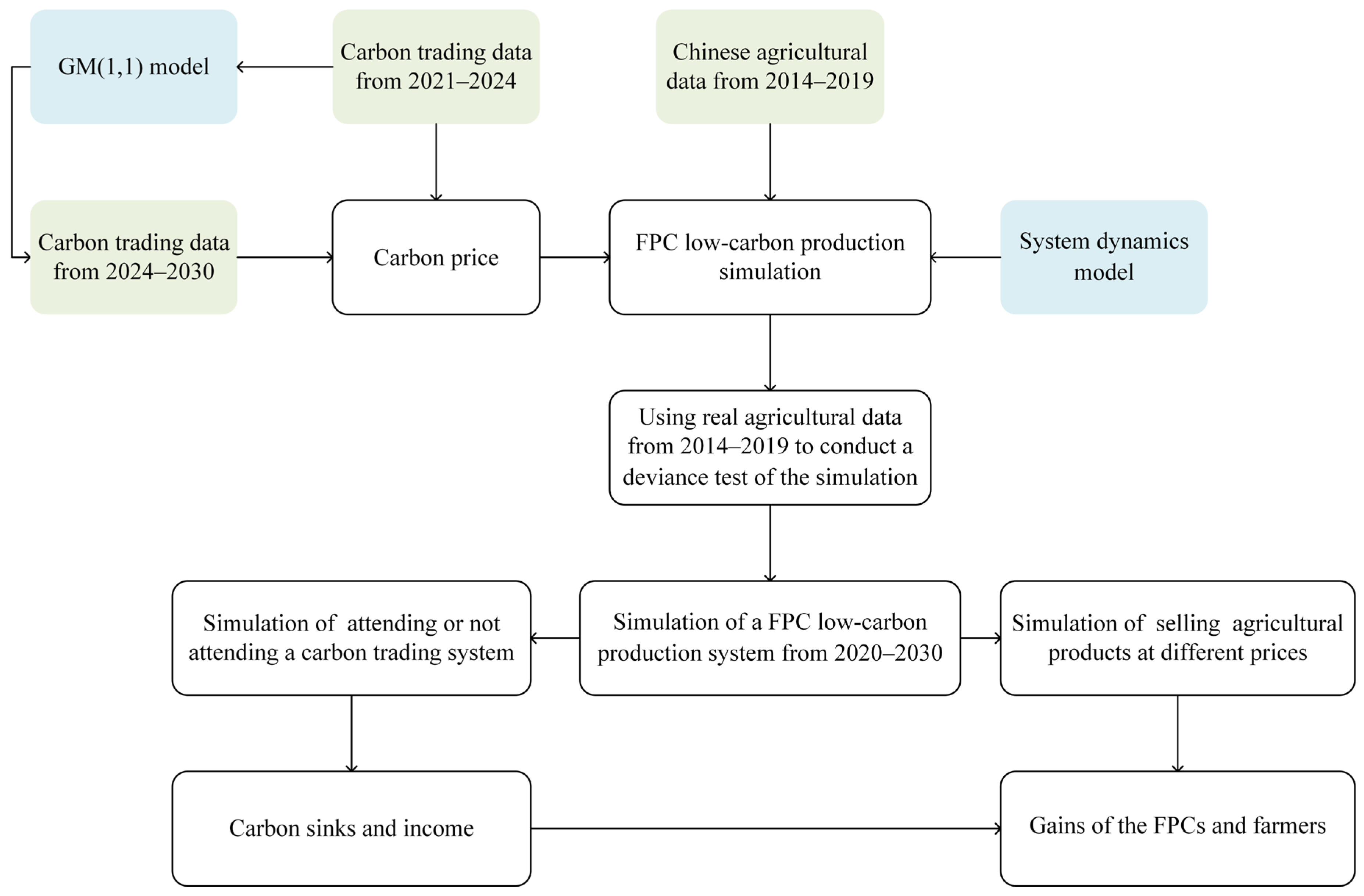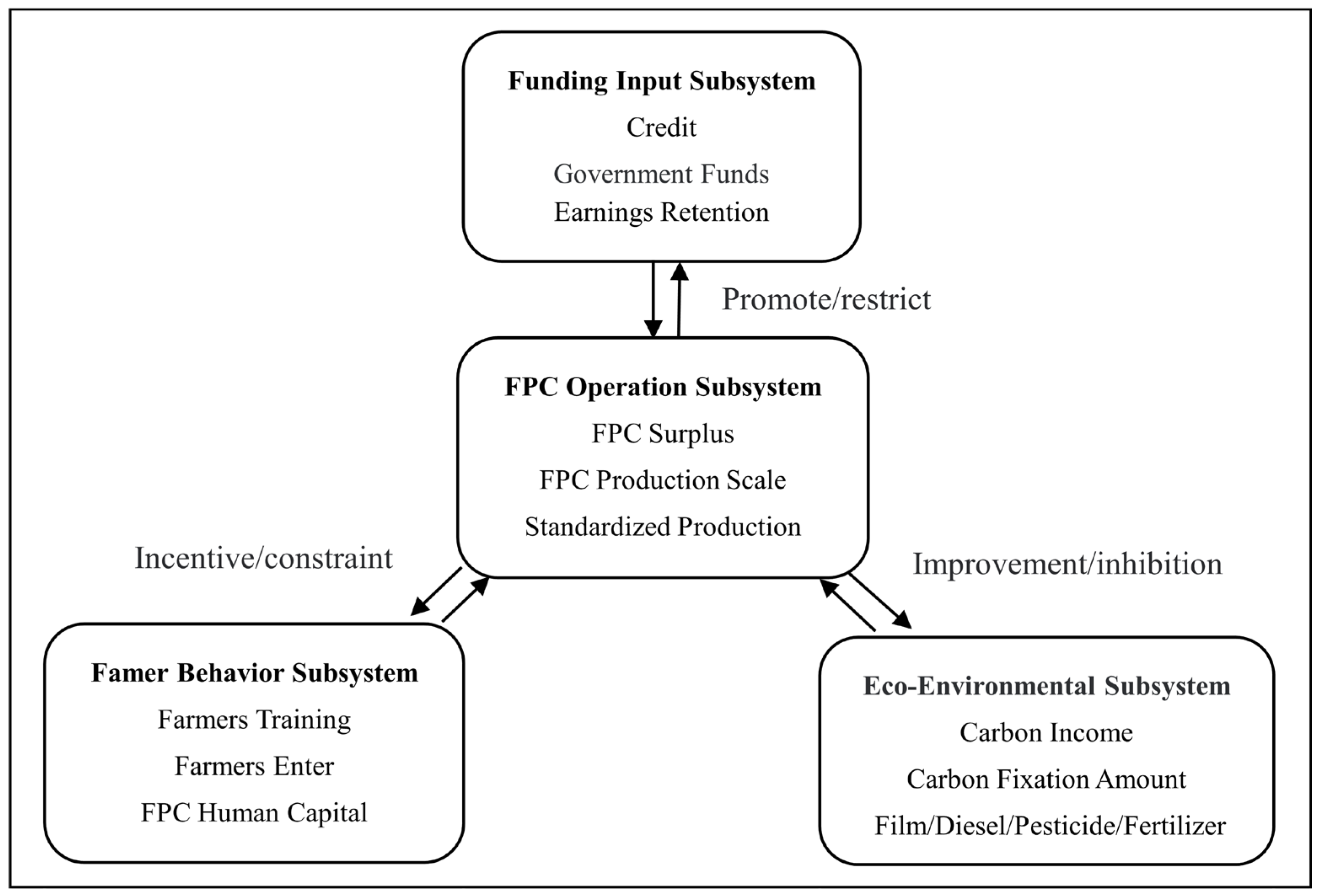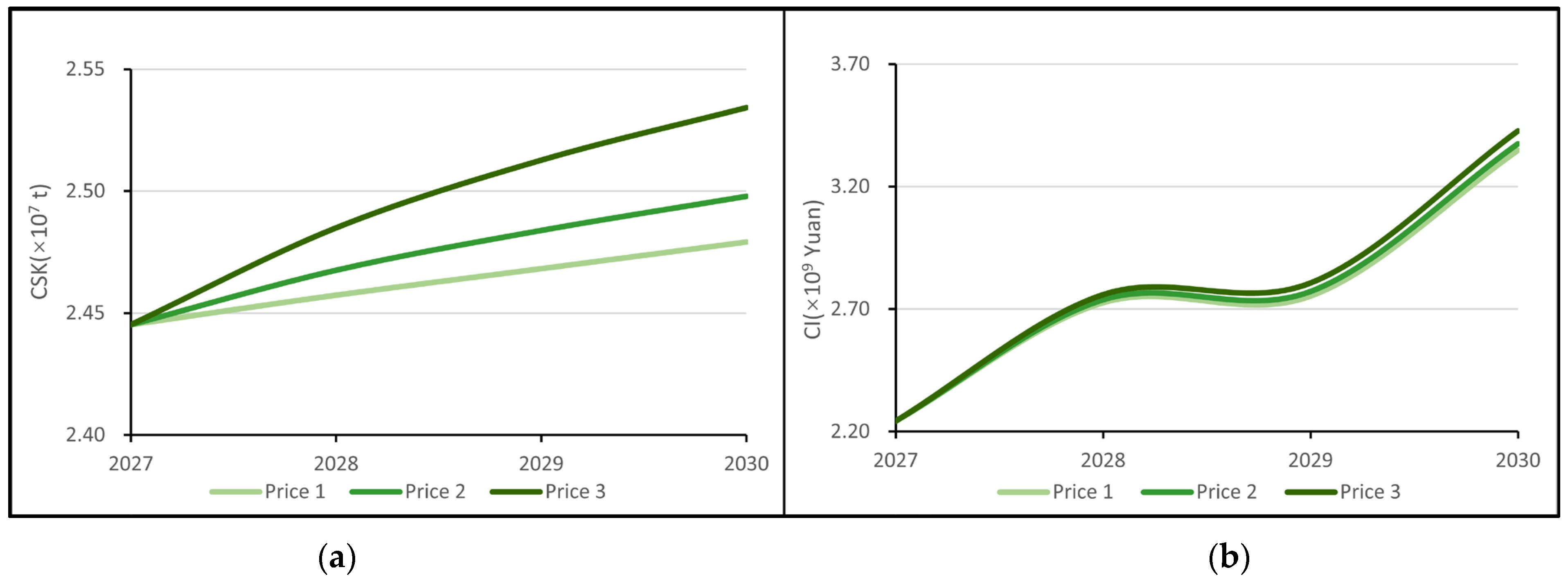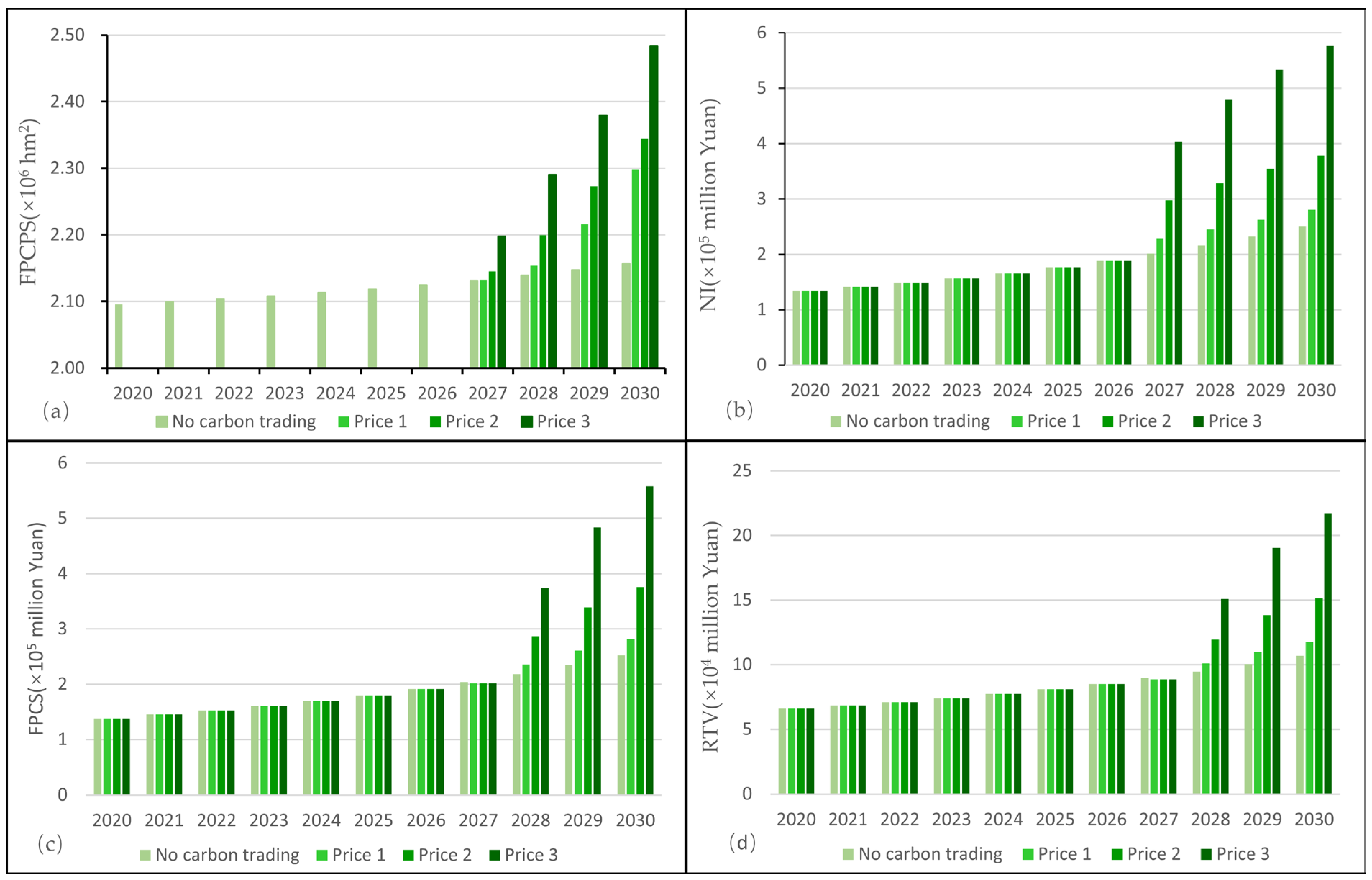A Simulation Study of How Chinese Farmer Cooperatives Can Drive Effective Low-Carbon Production Systems Through a Carbon Transaction Incentive
Abstract
1. Introduction
2. Materials and Methods
2.1. Data
2.2. System Dynamics Model
- The Funding Input Subsystem: This subsystem focuses on analyzing the dynamics of changes in FPC investment, encompassing both government funding and self-funding, as well as the trends in the inflow and outflow of FPC funding. The model treats FPC funds as the primary stock variable to assess the dynamic effects of aggregate investments that arise from a combination of funding sources, including self-funds and government support, on the operations of the cooperative.
- The FPC Operation Subsystem: This subsystem focuses on the operational scale, management system, and performance benefits of the FPC. The FPC Surplus serves as the primary stock variable within this framework. This subsystem specifically examines variations in factors such as investment and human capital, along with the dynamic development trends related to the operational scale, management system, and performance benefits of the FPC. The key feedback loops associated with the FPC Operation Subsystem are outlined in the following subsystems:
- The Farmer Behavior Subsystem: This subsystem primarily investigates the impact of farmers’ production behaviors on the operations of the FPC. Within this subsystem, the FPC human capital is identified as the primary stock variable, while supplementary factors, such as farmer training and farmer entry, are utilized to analyze the mechanisms that promote the relationship between farmers’ production behaviors and FPC operations.
- The Eco-Environmental Subsystem: This subsystem integrates the FPC carbon income into the operational subsystems of the FPC and analyzes the interactions between FPC operations and the ecological environment. Currently, agriculture, excluding forestry, has not been included in the carbon trading system; therefore, the ecological environmental subsystem is projected to commence in 2027.
2.3. The GM (1,1) Model
3. Results
3.1. Construction of the FPC Low Carbon Production System
3.2. Model Validity Testing
3.3. Simulation Results
3.3.1. Simulation of the Carbon Reduction Mechanism
3.3.2. Simulation of Carbon Sinks and Income
3.3.3. Simulation of the FPCPS, NI, FPCS, and RTV
4. Discussion
4.1. The FPC Low Carbon Production System
4.2. Carbon Sinks and Income Analysis
4.3. Gains of the FPC and Farmers
4.4. Future Research Directions
5. Conclusions and Policy Implications
5.1. Conclusions
- The implementation of a carbon transaction mechanism within the cropping industry is expected to result in a reduction in the use of fertilizers, films, diesel, and pesticides. Notably, in scenarios where agricultural production prices rise, these reductions are projected to be more pronounced.
- The establishment of a carbon transaction mechanism within the cropping industry is anticipated to enhance both carbon sinks and carbon income for FPCs and small-scale farmers. Similarly, in scenarios where agricultural products’ prices increase, these enhancements are expected to be more significant.
- Participation in carbon trading mechanisms can lead to an increase in the financial performance indicators of FPCs as well as enhance the net income and financial capacity of small-scale farmers. In a scenario where agricultural products’ prices rise, these increases are likely to be more pronounced.
5.2. Policy Implications
Author Contributions
Funding
Institutional Review Board Statement
Data Availability Statement
Acknowledgments
Conflicts of Interest
Appendix A
Appendix A.1. Equations for the FPC Low Carbon Production System
- The Funding Input Subsystemd(FD)/dt = IW − OWIW = GSF × FSF + SF + DN × 0.20OW = 0.80 × FundsSF = GSF × UR
- The FPC Operation Subsystemd(FPCS)/dt = NI − DNNI = 19971.32 + 0.06 × USAP + 5325.51 × SP + CIDN = FPCS × 0.92DS = 0.70 × DNRTV = DS × LRF + ADFFPCPS = 2,050,000.00+5.00 × FEUPPM = 95,921.81 + 3.17 × RTV + 0.03 × FPCPSUSAP = 450,111.13 + 1.11 × UPPMSP = 1.43 + 0.94 × BMBM = 6.47 + 0.0001 × FPCHC + 0.000001 × OW
- The Farmer Behavior Subsystemd(FPCHC)/dt = ISIS = TSF × FTFE = −966.66 + 0.44 × FT+0.10 × RTVFT = −1123.04 + 870.08 × BM
- The Eco-Environmental Subsystemd(CFA)/dt = CSK − CSCCSK = CFF × FPCPSCSC = TEC × FPCPS + IECT × FPCPS + 8956.00 × FZ + 49,341.00 × PD +
51,800.00 × FM + 5927.00 × DLRV = CFA × VFCI = CP × RVDL = 73.96 − 1.16 × SPFL = 8.76 − 0.11 × SPPD = 6.10 − 0.14 × SPFZ = 204.29 − 2.93 × SP
References
- Huang, X.; Xu, X.; Wang, Q.; Zhang, L.; Gao, X.; Chen, L. Assessment of Agricultural Carbon Emissions and Their Spatiotemporal Changes in China, 1997–2016. Int. J. Environ. Res. Public Health 2019, 16, 3105. [Google Scholar] [CrossRef]
- Wang, H.; Zhang, L. Research on Farmers’ Low-Carbon Production Behavior: Introducing Green Cognition into the Theory of Planned Behavior. Pol. J. Environ. Stud. 2024, 33, 873–884. [Google Scholar] [CrossRef]
- Jiang, L.; Huang, H.; He, S.; Huang, H.; Luo, Y. What motivates farmers to adopt low-carbon agricultural technologies? Empirical evidence from thousands of rice farmers in Hubei province, central China. Front. Psychol. 2022, 13, 983597. [Google Scholar] [CrossRef]
- North, D.C. Institutions, Institutional Change and Economic Performance; Cambridge University Press: Cambridge, UK, 1990. [Google Scholar] [CrossRef]
- Hao, J.; Bijman, J.; Gardebroek, C.; Heerink, N.; Heijman, W.; Huo, X. Cooperative Membership and Farmers’ Choice of Marketing Channels–Evidence from Apple Farmers in Shaanxi and Shandong Provinces, China. Food Policy 2018, 74, 53–64. [Google Scholar] [CrossRef]
- Kang, M. A Brief Analysis of Low-Carbon Agriculture Development Pattern. Bus. Manag. Res. 2013, 2, 96. [Google Scholar] [CrossRef]
- Cui, Y.; Khan, S.U.; Deng, Y.; Zhao, M.; Hou, M. Environmental Improvement Value of Agricultural Carbon Reduction and Its Spatiotemporal Dynamic Evolution: Evidence from China. Sci. Total Environ. 2020, 754, 7398. [Google Scholar] [CrossRef]
- Wang, Y.; Zhang, T.; Wang, X.; Jiang, B.; Wu, X.; Huang, X. Urbanization and Agricultural Carbon Emissions: The Mediation Effect of Agricultural Land Use Change. Pol. J. Environ. Stud. 2024, 33, 3927–3939. [Google Scholar] [CrossRef]
- Yu, L.; Chen, C.; Niu, Z.; Gao, Y.; Yang, H.; Xue, Z. Risk Aversion, Cooperative Membership and the Adoption of Green Control Techniques: Evidence from China. J. Clean. Prod. 2021, 279, 123288. [Google Scholar] [CrossRef]
- Sambuo, D. Co-Operatology and the Science of Cooperative Societies: A Synthetic Review of Research on Cooperative Evolution. J. Coop. Organ. Manag. 2023, 11, 100190. [Google Scholar] [CrossRef]
- Spear, R. The Co-Operative Advantage. Ann. Public Coop. Econ. 2000, 71, 507–523. [Google Scholar] [CrossRef]
- Ma, W.; Renwick, A.; Yuan, P.; Ratna, N. Agricultural Cooperative Membership and Technical Efficiency of Apple Farmers in China: An Analysis Accounting for Selectivity Bias. Food Policy 2018, 81, 122–132. [Google Scholar] [CrossRef]
- Ma, D.; Wang, X.; Guo, Z.; Yu, T. An evolutionary game theory–based study examining the relationship between fiscal policy, stability of farmers’ cooperatives, and environmentally friendly digital management. Environ. Sci. Pollut. Res. 2024, 31, 909–930. [Google Scholar] [CrossRef]
- Deng, H.; Huang, J.; Xu, Z.; Rozelle, S. Policy support and emerging farmer professional cooperatives in rural China. China Econ. Rev. 2010, 21, 495–507. [Google Scholar] [CrossRef]
- Liu, Y.; Cao, L.; Wang, Y.; Liu, E. Viability, Government Support and the Service Function of Farmer Professional Cooperatives—Evidence from 487 Cooperatives in 13 Cities in Heilongjiang, China. Agriculture 2024, 14, 616. [Google Scholar] [CrossRef]
- Ma, G.; Chen, J. Study on development capability of small farmer cooperative organization in rural revitalization. In Proceedings of the International Academic Conference on Frontiers in Social Sciences and Management Innovation (IAFSM 2018), Chongqing, China, 17–18 November 2018; Atlantis Press: Dordrecht, The Netherlands, 2019; pp. 1–5. [Google Scholar] [CrossRef]
- Zheng, Y.; Lou, J.; Mei, L.; Lin, Y. Research on digital credit behavior of farmers’ cooperatives—A grounded theory analysis based on the “6C” family model. Agriculture 2023, 13, 1597. [Google Scholar] [CrossRef]
- Yi, Z.; Wang, Y.; Chen, Y.J. Financing an agricultural supply chain with a capital-constrained smallholder farmer in developing economies. Prod. Oper. Manag. 2021, 30, 2102–2121. [Google Scholar] [CrossRef]
- Nzamurambaho, F.; Ekowati, T.; Gayatri, S. Factors Influencing the Profitability of Agricultural Cooperative Members: Case of Tuzamurane Cyeza Cooperative, Muhanga District, Rwanda. Agro Ekon. 2023, 35, 124–141. [Google Scholar] [CrossRef]
- Yu, X.; Liu, W.; Qing, L.; Zhang, D. Improving farm cooperatives’ performance and sustainability: A study of agricultural managers’ competencies based on the grounded theory and the fsQCA methods. Sustainability 2023, 15, 1263. [Google Scholar] [CrossRef]
- Ran, G.; Wang, G.; Du, H.; Lv, M. Relationship of cooperative management and green and low-carbon transition of agriculture and its impacts: A case study of the western tarim river basin. Sustainability 2023, 15, 8900. [Google Scholar] [CrossRef]
- Wang, J.; Zhang, X.; Li, R. The Role of Farmers’ Cooperatives in Promoting Agricultural Green Development: Empirical Evidence from China. J. Clean. Prod. 2022, 330, 129862. [Google Scholar] [CrossRef]
- Wang, H.; Qiu, T. The effects of farmer cooperatives on agricultural carbon emissions reduction: Evidence from rural China. J. Clean. Prod. 2024, 450, 141881. [Google Scholar] [CrossRef]
- Sun, X.; Liu, W.; Xu, D. Agricultural Cooperatives and Their Contribution to Farmers’ Sustainable Development—A Case Study of Organic Tea Growers in China. Sustainability 2019, 11, 2631. [Google Scholar] [CrossRef]
- Ajates, R. An Integrated Conceptual Framework for the Study of Agricultural Cooperatives: From Repolitisation to Cooperative Sustainability. J. Rural Stud. 2020, 78, 467–479. [Google Scholar] [CrossRef]
- Zhao, L.; Yang, B. The Impact of Cooperative Membership on Farmers’ Adoption of Low-Carbon Agricultural Practices. J. Rural Stud. 2022, 90, 117–128. [Google Scholar] [CrossRef]
- Zou, J.; Shen, L.; Wang, F.; Tang, H.; Zhou, Z. Dual carbon goal and agriculture in China: Exploring key factors influencing farmers’ behavior in adopting low carbon technologies. J. Integr. Agric. 2024, 23, 3215–3233. [Google Scholar] [CrossRef]
- Hou, J.; Hou, B. Farmers’ adoption of low-carbon agriculture in China: An extended theory of the planned behavior model. Sustainability 2019, 11, 1399. [Google Scholar] [CrossRef]
- Li, F.; Tang, X.; Zhang, P. The Impact of Cooperative Participation on Farmers’ Adoption of Green Production Technologies. Sci. Total Environ. 2021, 771, 145418. [Google Scholar] [CrossRef]
- Xie, J.; Wang, Z.; Huang, X. Farmers’ Cooperatives and Rural Environmental Governance: A Study Based on Chinese Agricultural Carbon Emissions. J. Rural Stud. 2023, 98, 34–47. [Google Scholar] [CrossRef]
- Huo, Y.; Mi, G.; Zhu, M.; Chen, S.; Li, J.; Hao, Z.; Cai, D.; Zhang, F. Carbon footprint of farming practices in farmland ecosystems on the North and Northeast China plains. J. Environ. Manag. 2024, 354, 120378. [Google Scholar] [CrossRef]
- Feng, J.; Zhao, L.D.; Zhang, Y.B.; Sun, L.X.; Yu, X.; Yu, Y. Can climate change influence agricultural GTFP in arid and semi-arid regions of Northwest China? J. Arid Land 2020, 12, 837–853. [Google Scholar] [CrossRef]
- Forrester, J.W. Learning through system dynamics as preparation for the 21st century. Syst. Dyn. Rev. 2016, 32, 187–203. [Google Scholar] [CrossRef]
- Saysel, A.K.; Barlas, Y.; Yenigün, O. Environmental sustainability in an agricultural development project: A system dynamics approach. J. Environ. Manag. 2002, 64, 247–260. [Google Scholar] [CrossRef]
- Winz, I.; Brierley, G.; Trowsdale, S. The use of system dynamics simulation in water resources management. Water Resour. Manag. 2009, 23, 1301–1323. [Google Scholar] [CrossRef]
- Rozman, Č.; Pažek, K.; Prišenk, J.; Škraba, A.; Kljajić, M. System dynamics model for policy scenarios of organic farming development. Organizacija 2012, 45, 212–218. [Google Scholar] [CrossRef]
- Li, F.J.; Dong, S.C.; Li, F. A system dynamics model for analyzing the eco-agriculture system with policy recommendations. Ecol. Model. 2012, 227, 34–45. [Google Scholar] [CrossRef]
- Bastan, M.; Khorshid-Doust, R.R.; Sisi, S.D.; Ahmadvand, A. Sustainable development of agriculture: A system dynamics model. Kybernetes 2018, 47, 142–162. [Google Scholar] [CrossRef]
- Egerer, S.; Cotera, R.V.; Celliers, L.; Costa, M.M. A leverage points analysis of a qualitative system dynamics model for climate change adaptation in agriculture. Agric. Syst. 2021, 189, 103052. [Google Scholar] [CrossRef]
- Deng, J.L. Introduction to grey system theory. J. Grey Syst. 1989, 1, 1–24. Available online: https://dl.acm.org/doi/10.5555/90757.90758 (accessed on 1 January 2023).
- Niu, B.; Dong, J.; Dai, Z.; Jin, J.Y. Market expansion vs. intensified competition: Overseas supplier’s adoption of blockchain in a cross-border agricultural supply chain. AgriSciRN Agric. Coop. 2021, 51, 101113. [Google Scholar] [CrossRef]
- Li, W.; Clark, B.; Taylor, J.A.; Kendall, H.; Jones, G.; Li, Z.; Jin, S.; Zhao, C.; Yang, G.; Shuai, C.; et al. A hybrid modelling approach to understanding adoption of precision agriculture technologies in Chinese cropping systems. Comput. Electron. Agric. 2020, 172, 105305. [Google Scholar] [CrossRef]
- He, Y.Q.; Zhu, S.; Zhang, Y.; Zhou, Y.C. Calculation, elasticity and regional differences of agricultural greenhouse gas shadow prices. Sci. Total Environ. 2021, 790, 148061. [Google Scholar] [CrossRef]
- Chen, Q.; Huang, J.; Mirzabaev, A. Does fuel price subsidy work? Household energy transition under imperfect labor market in rural China. Energy Econ. 2022, 107, 105845. [Google Scholar] [CrossRef]
- Ullah, A.; Arshad, M.; Kachele, H.; Khan, A.; Mahmood, N.; Müller, K. Information asymmetry, input markets, adoption of innovations and agricultural land use in Khyber Pakhtunkhwa, Pakistan. Land Use Policy 2020, 90, 104261. [Google Scholar] [CrossRef]
- Samuel, K.; Van der Heide, M.G.A. A Global Meta-Analysis of Yield Stability in Organic and Conservation Agriculture. Nat. Commun. 2018, 9, 3632. [Google Scholar] [CrossRef]
- Zhang, B.; Fu, Z.T.; Huang, J.; Wang, J.Q.; Xu, S.Y. Consumers’ perceptions, purchase intention, and willingness to pay a premium price for safe vegetables: A case study of Beijing, China. J. Clean. Prod. 2018, 197, 1498–1507. [Google Scholar] [CrossRef]
- Grashuis, J.; Ye, S.U. A Review of the Empirical Literature on Farmer Cooperatives: Performance, Ownership and Governance, Finance, and Member Attitude. Ann. Public Coop. Econ. 2018, 90, 77–102. [Google Scholar] [CrossRef]
- Candemir, A.; Duvaleix, S.; Latruffe, L. Agricultural Cooperatives and Farm Sustainability—A Literature Review. J. Econ. Surv. 2021, 35, 1118–1144. [Google Scholar] [CrossRef]
- Dong, C.; Wang, H.; Long, W.; Ma, J.; Cui, Y. Can Agricultural Cooperatives Promote Chinese Farmers’ Adoption of Green Technologies? Int. J. Environ. Res. Public Health 2023, 20, 4051. [Google Scholar] [CrossRef]
- Black, H.; Reed, M.; Kendall, H.; Parkhurst, R.; Cannon, N.; Chapman, P.J.; Orman, M.; Phelps, J.; Rudman, H.; Whalley, S.; et al. What makes an operational farm soil carbon code? Insights from a global comparison of existing soil carbon codes using a structured analytical framework. Carbon Manag. 2022, 13, 554–580. [Google Scholar] [CrossRef]





| Subsystem | Types of Variables | Stock, Flow, Ancillary Variables, and Parameters |
|---|---|---|
| Funding Input Subsystem | Endogenous variables | Funds (FD), inflow (IW), outflow (OW), self-funding (SF) |
| Exogenous variables | Funding support factor (FSF), government support funds (GSF), unsupported ratio (UR), distribution (DN) | |
| FPC Operation Subsystem | Endogenous variables | FPC surplus (FPCS), net income (NI), DN, FPC production scale (FPCPS), uniform purchasing production materials (UPPM), uniform sales agricultural products (USAP), distributable surplus (DS), return by transactions volume (RTV), brand management (BM), standardized production (SP) |
| Exogenous variables | Adjustment distribution factor (ADF), legal regulation factors (LRF), farmers enter (FE), carbon income (CI) | |
| Farmer Behavior Subsystem | Endogenous variables | FPC human capital (FPCHC), increase (IS), famer training (FT), FE |
| Exogenous variables | Talent support factor (TSF), BM | |
| Eco-Environmental Subsystem | Endogenous variables | Carbon fixation amount (CFA), carbon sinks (CSK), carbon source (CSC), reduction verification (RV), CI, fertilizer (FZ), film (FM), diesel (DL), pesticide (PD) |
| Exogenous variables | FPCPS, verification factor (VF), carbon price (CP), carbon fixation factor (CFF), tilling emission coefficient (TEC), irrigation emission coefficient (IEC) |
| BM (×104 Pieces) | FPCS (×1011 RMB Yuan) | |||||
| Real value | Simulation value | Deviance degree | Real value | Simulation value | Deviance degree | |
| 2016 | 8.14 | 7.81 | 4.05% | 1.08 | 0.99 | 8.33% |
| 2018 | 8.68 | 9.47 | 9.10% | 1.16 | 1.25 | 7.76% |
| RTV (×1010 RMB Yuan) | FPCPS (×106 hm2) | |||||
| Real value | Simulation value | Deviance degree | Real value | Simulation value | Deviance degree | |
| 2016 | 5.68 | 5.16 | 9.15% | 1.94 | 2.08 | 7.22% |
| 2018 | 5.69 | 6.09 | 7.03% | 2.10 | 2.09 | 0.48% |
| SP (×104 pieces) | USAP (×1011 RMB Yuan) | |||||
| Real value | Simulation value | Deviance degree | Real value | Simulation value | Deviance degree | |
| 2016 | 8.95 | 8.80 | 1.68% | 8.28 | 7.99 | 3.50% |
| 2018 | 10.01 | 10.37 | 3.60% | 8.18 | 8.31 | 1.59% |
| FZ (t/hm2) | FL (×10−1 t/hm2) | |||||||
| Original value | Price 1 | Price 2 | Price 3 | Original value | Price 1 | Price 2 | Price 3 | |
| 2030 | 0.5417 | 0.5106 | 0.5002 | 0.4713 | 0.2558 | 0.2416 | 0.2368 | 0.2233 |
| DL (t/hm2) | PD (×10−2 t/hm2) | |||||||
| Original value | Price 1 | Price 2 | Price 3 | Original value | Price 1 | Price 2 | Price 3 | |
| 2030 | 0.1832 | 0.1734 | 0.1699 | 0.1603 | 0.9501 | 0.8855 | 0.8672 | 0.8173 |
Disclaimer/Publisher’s Note: The statements, opinions and data contained in all publications are solely those of the individual author(s) and contributor(s) and not of MDPI and/or the editor(s). MDPI and/or the editor(s) disclaim responsibility for any injury to people or property resulting from any ideas, methods, instructions or products referred to in the content. |
© 2025 by the authors. Licensee MDPI, Basel, Switzerland. This article is an open access article distributed under the terms and conditions of the Creative Commons Attribution (CC BY) license (https://creativecommons.org/licenses/by/4.0/).
Share and Cite
Feng, J.; Li, H.; Cannon, N.; Chang, X.; Chu, Q. A Simulation Study of How Chinese Farmer Cooperatives Can Drive Effective Low-Carbon Production Systems Through a Carbon Transaction Incentive. Systems 2025, 13, 260. https://doi.org/10.3390/systems13040260
Feng J, Li H, Cannon N, Chang X, Chu Q. A Simulation Study of How Chinese Farmer Cooperatives Can Drive Effective Low-Carbon Production Systems Through a Carbon Transaction Incentive. Systems. 2025; 13(4):260. https://doi.org/10.3390/systems13040260
Chicago/Turabian StyleFeng, Jian, Haoyang Li, Nicola Cannon, Xianmin Chang, and Qianqian Chu. 2025. "A Simulation Study of How Chinese Farmer Cooperatives Can Drive Effective Low-Carbon Production Systems Through a Carbon Transaction Incentive" Systems 13, no. 4: 260. https://doi.org/10.3390/systems13040260
APA StyleFeng, J., Li, H., Cannon, N., Chang, X., & Chu, Q. (2025). A Simulation Study of How Chinese Farmer Cooperatives Can Drive Effective Low-Carbon Production Systems Through a Carbon Transaction Incentive. Systems, 13(4), 260. https://doi.org/10.3390/systems13040260






